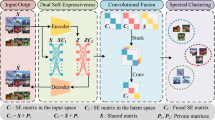Abstract
Most existing semi-supervised clustering algorithms are not designed for handling high-dimensional data. On the other hand, semi-supervised dimensionality reduction methods may not necessarily improve the clustering performance, due to the fact that the inherent relationship between subspace selection and clustering is ignored. In order to mitigate the above problems, we present a semi-supervised clustering algorithm using adaptive distance metric learning (SCADM) which performs semi-supervised clustering and distance metric learning simultaneously. SCADM applies the clustering results to learn a distance metric and then projects the data onto a low-dimensional space where the separability of the data is maximized. Experimental results on real-world data sets show that the proposed method can effectively deal with high-dimensional data and provides an appealing clustering performance.
Similar content being viewed by others
Explore related subjects
Discover the latest articles and news from researchers in related subjects, suggested using machine learning.References
Wagstaff K, Cardie C, Rogers S, Schroedl S. Constrained k-means clustering with background knowledge. In: Proceedings of International Conference on Machine Learning (ICML), 2001, 577–584
Basu S, Bilenko M, Mooney R. A probabilistic framework for semi-supervised clustering. In: Proceedings of International Conference on Knowledge Discovery and Data Mining (SIGKDD), 2004, 59–68
Lu Z, Leen T. Semi-supervised learning with penalized probabilistic clustering. In: Advances in neural information processing systems 17 (NIPS), 2005, 849–856
Xing E P, Ng A Y, Jordan M I, Russell S. Distance metric learning with application to clustering with side-information. In: Advances in Neural Information Processing Systems 15 (NIPS), 2003, 505–512
Xiang S M, Nie F P, Zhang C S. Learning a Mahalanobis distance metric for data clustering and classification. Pattern Recognition, 2008, 41(12): 3600–3612
Bar-Hillel A, Hertz T, Shental N, Weinshall D. Learning Distance Functions Using Equivalence Relations. In: Proceedings of International Conference on Machine Learning (ICML), 2003, 11–18
Yeung D Y, Chang H. A kernel approach for semi-supervised metric learning. IEEE Transactions on Neural Networks, 2007, 18(1): 141–149
Tsang I W, Cheung P M, Kwok J T. Kernel Relevant Component Analysis for Distance Metric Learning. In: Proceedings of International Joint Conference on Neural Networks (IJCNN), 2005, 954–959
Yeung D Y, Chang H. Extending the relevant component analysis algorithm for metric learning using both positive and negative equivalence constraints. Pattern Recognition, 2006, 39(5): 1007–1010
Zhang D Q, Zhou Z H, Chen S C. Semi-supervised Dimensionality Reduction. In: Proceedings of SIAM International Conference on Data Mining (SDM), 2007, 629–634
Tang W, Xiong H, Zhong S, Wu J. Enhancing Semi-Supervised Clustering: A Feature Projection Perspective. In: Proceedings of ACM SIGKDD International Conference on Knowledge Discovery and Data Mining (SIGKDD), 2007, 707–716
Bilenko M, Basu S, Mooney R J. Integrating Constraints and Metric Learning in Semi-Supervised Clustering. In: Proceedings of International Conference on Machine Learning (ICML), 2004, 81–88
Cai D, He X F, Han J W. Semi-Supervised Discriminant Analysis. In: Proceedings of International Conference on Computer Vision (ICCV), 2007, 1–7
Jolliffe I. Principal Component Analysis. 2nd edition. Berlin: Springer, 2002
Yin X S, Hu E L, Chen S C. Discriminative semi-supervised clustering analysis with pairwise constraints. Journal of Software, 2008, 19(11): 2791–2802 (in Chinese)
Dhillon I S, Guan Y, Kulis B. A unified view of kernel k-means, spectral clustering and graph partitioning. Technical report. Department of Computer Sciences, University of Texas at Austin, 2005
Tseng P. Convergence of a block coordinate descent method for nondifferentiable minimization. Journal of Optimization Theory and Applications, 2001, 109(3): 475–494
Martinez A M, Kak A C. PCA versus LDA. IEEE Transactions on Pattern Analysis and Machine Intelligence, 2001, 23(2): 228–233
Ding C. Li T. Adaptive dimension reduction using discriminant analysis and k-means clustering. In: Proceedings of International Conference on Machine Learning (ICML), 2007, 521–528
Ye J, Zhao Z, Wu M. Discriminative K-Means for Clustering. In: Advances in Neural Information Processing Systems 19 (NIPS), 2007, 1649–1656
Ye J P, Zhao Z, Liu H. Adaptive Distance Metric Learning for Clustering. In: Proceedings of Computer Society Conference on Computer Vision and Pattern Recognition (CVPR), 2007, 1–7
Wu M. Scholkopf B. A Local Learning Approach for Clustering. In: Advances in Neural Information Processing Systems 18 (NIPS), 2006, 1529–1536
Wang F, Zhang C, Li T. Clustering with Local and Global Regularization. In: Proceedings of Conference on Artificial Intelligence (AAAI), 2007, 657–662
Author information
Authors and Affiliations
Corresponding author
Rights and permissions
About this article
Cite this article
Yin, X., Hu, E. Distance metric learning guided adaptive subspace semi-supervised clustering. Front. Comput. Sci. China 5, 100–108 (2011). https://doi.org/10.1007/s11704-010-0376-9
Received:
Accepted:
Published:
Issue Date:
DOI: https://doi.org/10.1007/s11704-010-0376-9




